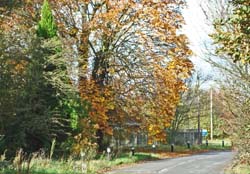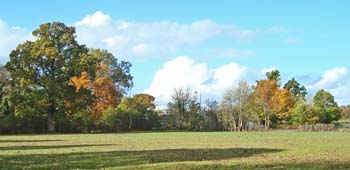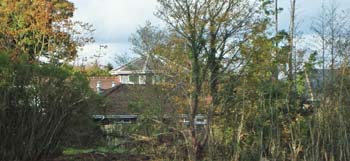Mental handicap
On 17th October 1899 the LCC bought Farmfield, an estate near Horley, which had once been owned by William Pitt Amherst, 1st Earl Amherst. The estate, which comprised 374 acres of land and contained two mansion houses, was purchased for £13,000, while another £7,000 was spent in adapting its buildings for patient and staff accommodation.
The Farmfield Reformatory for Inebriate Women opened without ceremony on 28th August 1900, initially with 30 beds in the main house for patients. The staff were housed in the Home Farm building some 300 yards away. Both buildings had electric lighting (generated at a station near the garden) and a telephone system.
The main Recreation and Dining Room for the patients was brightly and prettily furnished, with a harmonium and a piano. The Reformatory also had a large wash-house with drying rooms and well-ventilated work rooms.
Adjoining the old mansion house was a picturesque flower garden with a lawn and a lake. At the rear of the house was a large vegetable garden, which provided both supplies and employment to the inmates. To the north was an airing court within an unclimbable fence; this had a cinder path for exercise in bad weather.
Of course, no alcohol was permitted on the estate. A system of marks was arranged so that well-behaved and industrious women could earn a small sum of money against their departure. In the back court was an ominously heavy door marked 'Punishment Cell'. Although light and spacious, the cell was resorted to only when moral persuasion had been exhausted (intractable cases of destructive and turbulant nature - some 10 to 12% of the inmates - would be transferred to the newly opened State Reformatory at Aylesbury).
The demand for accommodatoion soon increased and, by November 1902, six new villas had been built to house an additional 80 patients, at a cost of £23,000. The buildings enabled classification of the inmates according to the amenities and liberty permitted.
Each villa had its own Day Room, Dining Room and small kitchen, and each patient had her own brightly furnished bedroom. A corridor connected the villas to the main building with its central offices, the large kitchen and storeroom, and the chapel.
The better-behaved patients were employed in the dairy farm, located at the Home Farm, which had a well-appointed cowhouse, dairy and bakehouse. The women were instructed in butter-making and baking, etc. Other outdoor duties for the women were poultry farming, bee-keeping, fruit farming, potato-picking, weeding and hay-making, and were intended to take them back to a simple natural life and instill a sense of home into the environment.
The staff consisted of a Matron and 25 others. A doctor called daily, but there was little serious illness among the patients, and the Rector of a neighbouring parish acted as a chaplain.
The weekly cost of an inmate was £1 12s 3d (£1.61).
By 1912 the Reformatory was considered unviable. The percentage of inebriates who benefitted from the reformatory treatment was extremely low. Of the first 600 cases detained there, some 19% were said to be doing well (although this figure was doubtful), 3% did well for a considerable period, 45% relapsed and 15% could not be traced (the balance was accounted for by death and other causes). The Public Control Committee decided to dispose of the estate, but land values were low and it was decided not to sell. However, the Reformatory closed in November 1915, during WW1, and the 45 inmates were transferred to the institution at Brentry, near Bristol.
In 1916 the Reformatory became the Farmfield State Institution for female delinquent mentally deficient patients. By 1921 the buildings were in a state of disrepair and the Institution closed in 1922.
The buildings were renovated by the LCC's Mental Hospital Committee and, in January 1925, they opened again, this time as Farmfield Hospital, to house 180 high grade, intractable mentally deficient male patients.
Three of the 2-storey villas accommodated 40 patients each, while the fourth one and a hostel housed 20 each, thus allowing a certain amount of segregation. All the villas were 'open', except for one, which was used for the most difficult patients who were closely supervised.
In 1948 the Hospital joined the NHS under the control of the Royal Earlswood Hospital Management Committee, part of the South West Metropolitan Regional Hospital Board. It became a halfway house for difficult cases (those who remained unimproved were sent to Rampton Hospital in Nottinghamshire).
In 1949 the Hospital had 161 beds for high grade mentally deficient men of criminal propensity and of intractable disposition, nearly all from London. The daily average of those in residence was 150, as a number of beds was held in reserve for re-admission of patients 'without leave' and for those who returned from 'trial on licence'. Some 42 patients were on daily licence, employed locally in domestic service, hotels, cafes, shops and coal merchants. Those not on licence were employed on the farm, the wards and in the Hospital's workshops.
As well as ward accommodation, the Hospital had training facilities, a school and an all-purpose hall where the patients could enjoy organsed entertainment. They could also participate in sports and games in the large outdoor recreation area.
In 1955 a ward was opened for male patients with challenging behaviour.
In 1961, when the Hospital had 180 beds (and 172 patients), the engineering services were modernised. The sewage disposal plant was disconnected and connected to the mains service. The sanitary facilities in Haig House and French House were improved and the kitchen remodelled. Four new staff houses were built. The Training Centre was extended and an Industrial Unit established.
The high grade industrial workshops provided employment for 18 boys working under factory conditions. Some 71 patients worked in the Outdoor Therapy Training Unit, handicrafts or in light industrial assembly - making clipped pins and coil bobbins, line taps and junction moulds - or in box assembly and car brushes packing, on contract from firms in the Crawley industrial area. Some 12 patients went to work daily in nearby factories or hotels, while 18 were employed in the Hospital, farm or garden, another 18 in the workshops, kitchen and on laundry collection, and 24 on the wards. Three times a week, 24 high grade but illiterate patients attended evening school classes.
In 1962 a Staff Social Centre was built. By this time almost one-third of the patients could be discharged as re-socialised or rehabiltated as responsible citizens. Of the remaining patients, 74 were over the age of 40 years.
The inmates who worked on the farm provided great quantities of garden produce for the institution. Some 360 acres was farmed until 1963, when some land was leased to a local farmer for grazing. In 1968 the Hospital ceased farming the land. Some 260 acres was sold at auction and 75 acres were leased but the remainder was retained, as were the cricket and football fields.
In 1969 the all-purpose hall was upgraded and the former farm hostel completely rebuilt. It re-opened as Charlwood Ward. In December 1970 the other blocks were renamed after local villages - Faygate, Ifield, Hookwood and Rusper.
In 1974, following a major reorganisation of the NHS, the Hospital, along with the Royal Earlswood Hospital, came under the control of the East Surrey District Health Authority, part of the Surrey Area Health Authority.In 1982, following another reorganisation, the Hospital was then managed by the East Surrey Learning Disability Service, under the control of the East Surrey Health Authority.
In 1985 the Hospital had 128 beds and had become ancillary to the Royal Earlswood Hospital.
In 1987 Hookwood Ward closed, but the other four residential units remained, as did the Occupational Therapy Department, the WVRS shop, the Social and Recreation Department, the staff quarters and the residents' club. The patients were gradually rehabilitated in the community or transferred to the Royal Earlswood Hospital. In September 1989 Rusper Ward closed. When the apartments in Shrewsbury Road, Redhill, were ready for the remaining 18 residents, Charlwood Ward closed.
The Hospital finally closed at the end of October 1989.
Present status (November 2011)
The site now contains Farmfield, a low and medium secure hospital with 52 beds for male patients aged over 18 years detained under the Mental Health Act (1983). It is run by the Priory Group and provides treatment and rehabilitation for patients with enduring mental illness, personality disorder and learning disabilities.

The entrance to the current Farmfield Hospital from Farmfield Drive, off Charlwood Road.

The buildings (above and below) are barely visible from the footpath to the east.

(Author unstated) 1900 Outside the gates. Women. Nursing Record and Hospital World, 1st September, 182.
(Author unstated) 1900 The London County Council's Inebriate Reformatory. British Medical Journal 2 (2070), 592-593.
(Author unstated) 1901 The London County Council's Inebriate Reformatory. British Medical Journal 2 (2121), 480-481.
(Author unstated) 1904 Outside the gates. Women. British Journal of Nursing, 29th October, 361.
(Author unstated) 1913 London County Council. Administration of the Inebriates Acts. British Medical Journal 2 (2745), 343.
Collins WJ 1903 The institutional treatment of inebriety. British Medical Journal 2 (2236), 1204-1208.
Hunt G, Mellor J and Turner J 1989 Wretched, Hatless and Miserable: Women and the Inebriate Reformatories from 1900-1913. British Journal of Sociology 40, 244-270.
http://studymore.org.uk
www.exploringsurreyspast.org.uk
www.prioritygroup.com
Return to home page